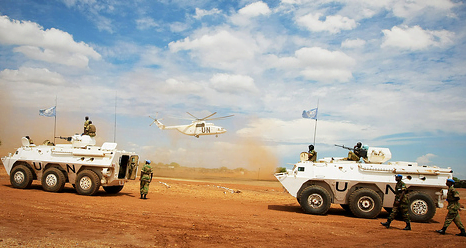

In early May of this year gubernatorial elections were held in Southern Kordofan. Shortly after, violence broke out and government security forces attacked the region.
In mid-May, violence broke out in the small demarcated territory of Abyei after forces from what would soon be the Republic of South Sudan attacked an UNMIS (United Nations Mission in Sudan) convoy escorting Sudan Armed Forces elements of a Joint Integrated Unit. The government responded with a military campaign in the region.
In early September, violence broke out in Blue Nile state and the government declared a state of emergency, replacing the recently elected SPLM-N governor with a military governor.
The Sudan People’s Liberation Movement (SPLM) was the political wing of the army (SPLA) that fought the insurgency in the south, in opposition to the government in the north, between 1983 and 2005. In 2005 the Comprehensive Peace Agreement (CPA) effectively brought the civil war to an end and provided for a referendum on independence for the south to take place six years later. The referendum was held in January 2011 and southerners voted overwhelmingly in favor of independence. On July 9 the Republic of South Sudan became the 193rd member of the United Nations.
But not all SPLA fighters or SPLM members were from South Sudan. Some SPLM/A fighters and supporters came from the border states of Southern Kordofan and Blue Nile. But the SPLM became the ruling party of South Sudan after independence, necessitating a political reorientation on the part of the SPLM in the border regions in which they are now identified as SPLM-North (SPLM-N). This is highly problematic from the perspective of Khartoum, which suspects that the SPLM-N is not just a political party that wants to see the removal of the current regime – which is bad enough – but is also being supported by military elements from South Sudan (a claim which the government of South Sudan denies). In mid-September, Khartoum outlawed 17 political parties it deemed to be aligned with the south and thus “foreign,” including SPLM-N. The ruling party in Khartoum is the National Congress Party (NCP).
In Southern Kordofan, Ahmed Haroun of the NCP, wanted by the International Criminal Court (ICC) for crimes in Darfur, won the gubernatorial election in May. The SPLM-N insists that the election was rigged. Shortly after the election, violence broke out for the first time since a 2002 ceasefire between the SPLM/A of Kordofan and the government. Toward the end of June, Khartoum reached a deal with the SPLM-N that also encompassed Blue Nile. Blue Nile is relatively evenly split between NCP and SPLM-N supporters. Large scale attacks on civilians by government forces and associated militia are ongoing since fighting began in early September.
The international reaction has been predictably limp, despite an UNMIS report that suggests crimes committed by government forces are egregious enough to justify referral to the ICC. The two main rebel groups in Darfur in the west – the Sudan Liberation Army (SLA) and the Justice and Equality Movement (JEM), which began fighting their own battle in 2003 – have expressed solidarity with the SPLM-N by calling for the Security Council to impose a no-fly zone over Darfur, Kordofan, and Blue Nile. The Sudan Tribune reported on September 4: “Darfur rebels today urged international community to impose a no-fly zone and to establish safe corridors to provide civilians, in the Blue Nile, Darfur and Southern Kordofan, with humanitarian assistance. They also urged democratic forces to join them in their efforts to change Bashir’s regime.” Humanitarian access has been another major problem, as Khartoum has rigidly restricted international humanitarian operations.
In 2008 the International Crisis Group released a report called “Sudan’s Southern Kordofan Problem: The Next Darfur?” which highlights the importance of the public consultations mandated by the CPA for the border states. Consultations have been stalled, however, and in July parliament voted to extend the deadline for consultations by six months. It is beginning to look as though the ICG prediction that another war could erupt is materializing, though perhaps on a scale a bit larger than they may have anticipated if the Darfuri groups are able to effectively partner with groups in Kordofan and Blue Nile.
Perhaps these disparate groups can iron out their differences enough to form an effective anti-NCP coalition, and perhaps a more robust international response could be forthcoming?; or perhaps the border states will have to fend for themselves? Whatever way this unfolds, the ruling party and, more importantly the military – which is becoming increasingly powerful independent of the political leadership – are unlikely to go anywhere without a fight.
